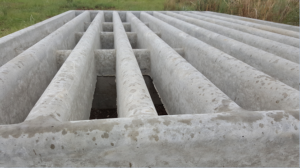More than 30 years ago the first Beton Cattle Grid was installed, today the grids have not only stood the test of time, but have also beaten the steel price increases.
While grids are normally constructed from thick steel bars, such as old railway lines, Beton Cattle Grids are manufactured with reinforced concrete. Measuring 3.5m x 2.2m x 0.45m (L x W x H), the grid weighs 2.8t.
With the tremendous increase in the price of steel, it has become too expensive to use the steel bars and it is difficult and expensive to obtain old railway bars. Since the steel bars are not cost effective, farmers are opting to install farm gates instead. Besides the inconvenience of constantly opening and closing gates, it is also a safety risk as the farmer is a prime hi-jacking target when he stops to get out his vehicle.
With a cattle grid, the farmer does not have to stop or exit his vehicle and the animals are still restricted to specific areas.
The bars of the Beton Cattle Grids are rounded, while the standard grid bars are flat. Animals cannot walk on the curved bars and they are too wide for animals to jump over.

Beton Cattle Grids have proved they are strong ough to handle any type of vehicle from sedans and light delivery vehicles to extra heavy trucks. The first units were produced and installed 30 years ago, and those units still look and work as good as new.
The Beton Cattle Grids are rust and weather resistant and bars remain firmly intact. After time, standard cattle grids can become untidy, with the steel bars bending and moving.
In terms of quality and price – The Beton Cattle Grid is a better product at a better price. It costs R27 000 plus VAT, purchased directly from the factory in KwaZulu-Natal, which is half the cost of a standard cattle grid. As the price of steel increases, so will the price gap increase.
It is suggested that crane-fitted trucks are used for collection and delivery (Own transport to be arranged).
Installation time is much less then the standard procedure and there is no waiting period for the cement to set. The grid can also be lifted out and moved to a new location if need be.
A very shallow dugout is required for the grid to fit into and soil is placed on the sides to act as on- and off-ramps. For the best result, submerge half-way and full the ramps up. This prevents the cattle-grid from flooding or becoming waterlogged during heavy rain.
